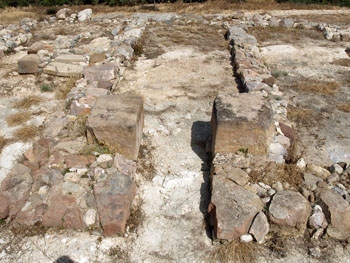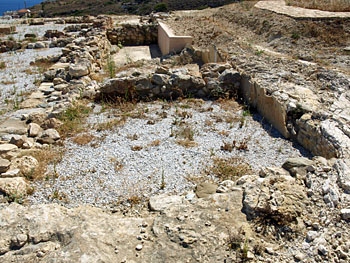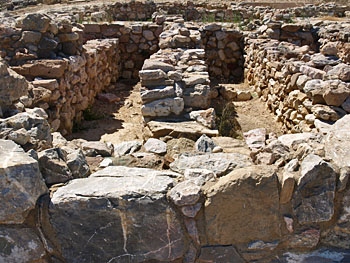Prepalatial Petras
The hill at Petras was occupied in the prepalatial Early Minoan IIB period. A number of separate buildings seem to have been constructed on a different orientation from the palace. The walls were constructed using unworked stones. The walls appear to have been covered in plaster, some of it painted red. Pottery finds included Vassiliki ware and other styles from the Mirabello area. A number of mortars and basins were found cut into the bedrock. A large number found on the eastern side of the hill were interpreted as a communal working area as they did not form part of any buildings. There is only very limited evidence of activity during the EM III-MM IA period. It is certain however that the palace had not been started during this period.
The first Palace
In Middle Minoan IIA everything began to change. Petras was clearly becoming an increasingly important centre as fine ceramics, stone vases and even a few seal impressions were found. The excavator describes the period as “one of increasing stress for a settlement attempting to fill a function for which it did not possess the necessary architecture.” A solution to this problem was not long in coming. Palaces elsewhere on the island had already been constructed during or possibly even before MM IB. At Petras, at some point in MM IIA the plateau was levelled and work on the palace began. The debris resulting from the levelling of the site in preparation for the new palace has revealed pottery, including Kamares ware, from the MM IB-MM IIA period. To the east of the palace a large cyclopean wall was constructed, the foundations of which can still be seen today.
A momumental staircase led up from the north to the central court of the First Palace, while the western staircase led to the upper floor of the West wing. The hieroglyphic archive, which had been located on the upper floor, was found to have fallen down into this doorway during the destruction of the first palace. The existence of the archive suggests that the storage of goods should have been somewhere close by. It wouldn't have been in the north magazines as these weren't built during the First Palace period but there is no obvious candidate in the plan of the First Palace.
One area still remaining from the First Palace is at the south west edge of the Palatial remains (see photo left). Here there are three rooms. In the first two, now covered with gravel, the floors were paved, while the second room was lined to the south and west with a bench. The south wall was lined with orthostats. It is thought to have had a possible religious function.
The first palace grew in importance during MM IIB but was destroyed within the same period. It was at this point that the hieroglyphic archive fell into the doorway.
The Second Palace
The second palace was built in the MM III-LM I period and since it is based on the ground plan of the first palace it may be that the destruction of the first palace was not too extensive. There were two building phases, each followed by a destruction. The first came in LM IA and the second some time in LM IB. Some changes were made, however. Firstly the south-eastern part of the first palace complex was completely abandoned. The north magazines were also constructed during this first phase and there may even have been two floors above the level we see today. The staircase where the hieroglyphic archive fell was not reused but rebuilding work was carried out in the north west corner of the palace.
From the central court a new corridor led through to the west facade although not much is known about the use of the rooms to the north and south of this corridor. The first phase of the Second Palace came to an end with a destruction in LM IA. Two deposits have been found from this destruction, both containing hundreds of conical cups.
Again the building seems to have survived relatively intact. The rooms south of the corridor are now used for storage. The monumental staircase went out of use. In its place an additional room was added to the north magazines. The central court was reduced in size by the building of a low wall on which were placed alternating columns and pillars so that the court was divided into two equal halves. The west was open and the east was basically a stoa.
Since the north west entrance, where the archive fell, was closed off in rebuilding during the first phase, and the main north entrance via the monumental staircase was closed off during the second phase of rebuilding, it seems that the orientation of the palace changed. As at many other sites in Crete during LM IB, storage becomes increasingly important and more areas of the palace are given over to storage. These include areas of the main building as well as the central court and, of course, the new room added to the north magazines.
Destruction and reoccupation
The palace was destroyed by intense fire with the upper floors collapsing and rubble covering the central court. The site was abandoned and not reoccupied until the Late Minoan IIIA. There is evidence that human occupation of the site continued into LM IIIB but the extremely scant evidence for LM IIIC is insufficient to establish if permanent occupation continued into this period.
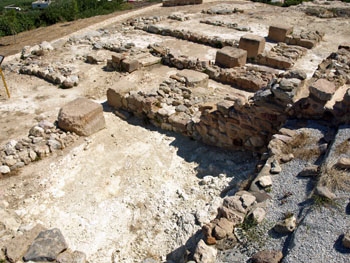
Storage magazines with part of grand staircase (bottom right) |
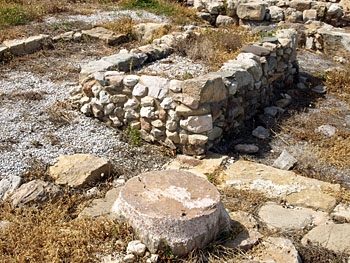
|

